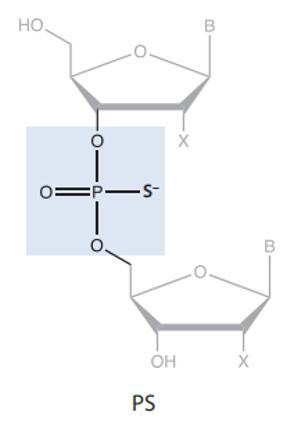Oligonucleotide therapeutics have great potential in the therapeutic areas of cancer, acquired immune diseases, congenital genetic disorders, and others. However, a major obstacle to the widespread use of oligonucleotide therapeutics is how to effectively deliver them to target organs and tissues other than the liver. Therefore, it is necessary to develop different delivery systems in practical applications to make oligonucleotide therapeutics more effective in diagnosing and treating diseases.
Common Backbone Modification
Common backbone modifications mainly include phosphorothioate (PS) modification, phosphorodiamidate morpholino oligomer (PMO) modification, and peptide nucleic acid (PNA) modification[1]. Alfa Chemistry often combines several modification methods to improve the properties of oligonucleotides.
PS modification
PS modification is a common strategy used in the chemical modification of oligonucleotides, in which one of the non-bridging oxygen atoms on a phosphodiester linkage is replaced with sulfur. PS modification is easy to incorporate into a standard oligonucleotide synthesis, and renders the in ternucleotide linkage more resistant to nuclease degradation. In addition, PS modification also has substantial pharmacokinetic benefits by increasing binding to plasma proteins, preventing rapid renal excretion, and promoting binding to cells.

PMO modification
PMOs are a class of oligonucleotide analogs where the ribofuranose ring and phosphodiester backbone of oligonucleotides are replaced with a morpholino ring and a phosphorodiamidate linkage, respectively (Figure 1a). PMOs are neutral and have similar affinity to DNA. However, they do not support RNase H activity and are used predominantly for translation arrest or for splice switching applications.
 Figure 1. Chemical structure of (a) PMO, ( b) DNA or RNA, and (c) PNA.
Figure 1. Chemical structure of (a) PMO, ( b) DNA or RNA, and (c) PNA.
PNA modification
PNAs are a class of oligonucleotide analogs where the sugar phosphate backbone of oligonucleotides is replaced with a peptide scaffold (Figure 1c.), yet maintain the ability to Watson-Crick base pair with complementary nucleic acids. PNAs are highly resistant to nuclease and protease degradation and are very stable when paired with RNA and DNA. PNAs do not support RNase H activity but have been used in translation inhibition and splice modulation antisense mechanisms.
What We Offer?
As the world's leading explorer of oligonucleotide therapeutics, Alfa Chemistry provides our customers with backbone modification services for therapeutic oligonucleotides. You can also contact us to customize any backbone-modified oligonucleotides you need.
Why Choose Us?
- Experienced experts
- Extensive chemical modification technologies
- Advanced analytical equipment
- Professional technical advice
- Competitive price
- Fast delivery
Reference
- Sun, Y.; et al. Enhancing the therapeutic delivery of oligonucleotides by chemical modification and nanoparticle encapsulation. Molecules. 2017, 22: 1724.
Our products and services are for research use only and cannot be used for any clinical purposes.




 Figure 1. Chemical structure of (a) PMO, ( b) DNA or RNA, and (c) PNA.
Figure 1. Chemical structure of (a) PMO, ( b) DNA or RNA, and (c) PNA.